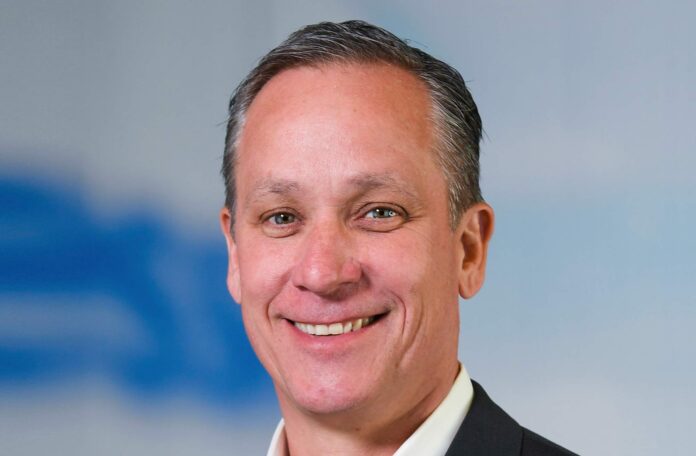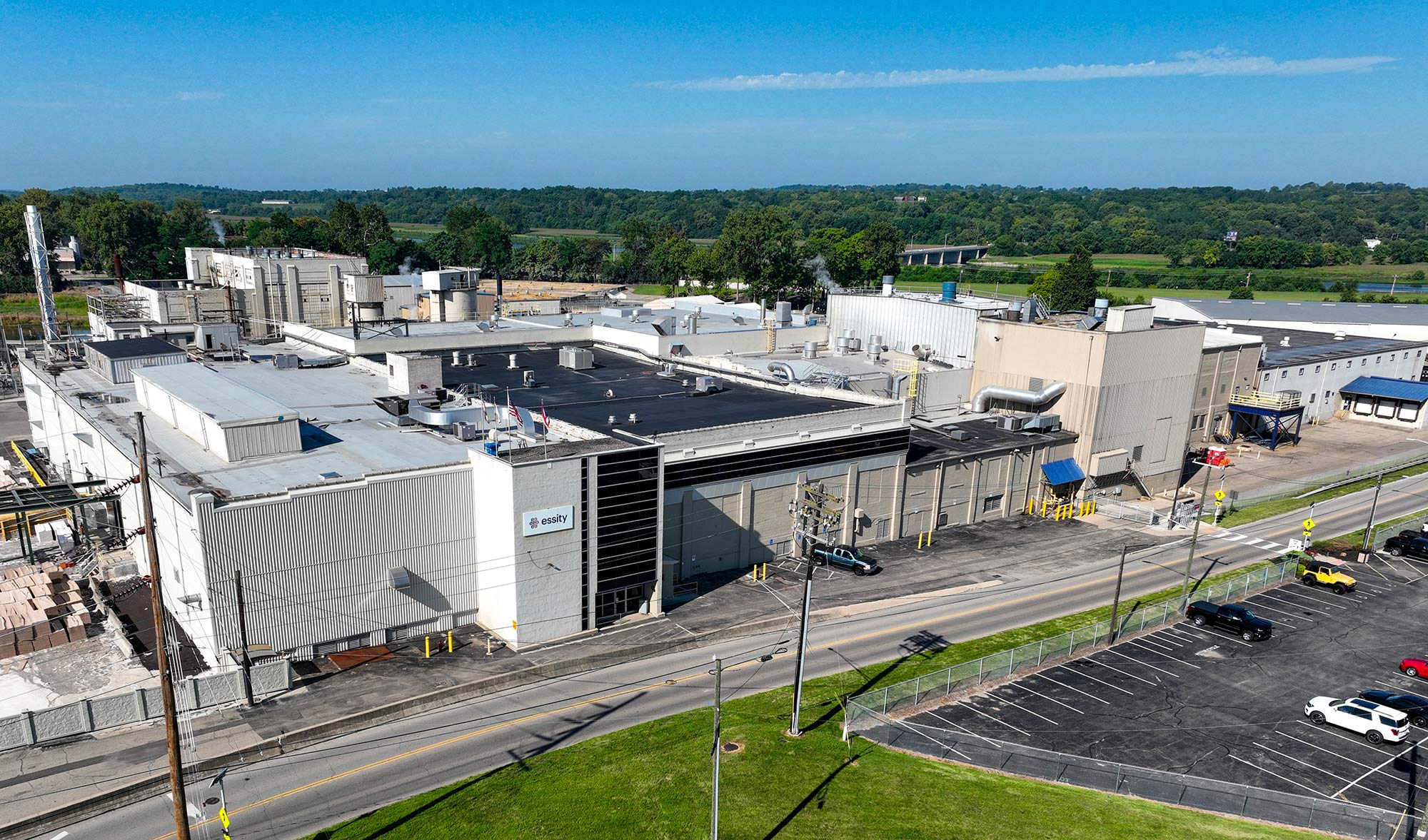
Fundamental restructuring has been a feature of 2023 across various regional operations for Essity. Here, TWM talks to Matthew Urmanski, North American Vice President Sales & Marketing for Essity’s Professional Hygiene business, to get the latest on the company’s plans in North America.
The past six months have been a particularly strategically important period for Swedish-headquartered Essity. Key points to include: the “continued high sales growth and higher margins” reported in its half-year report; fully exiting its business from the Russian market; securing £2.2m from the UK government to trial the use of hydrogen power at its paper manufacturing plant in north-west England; announcing an ongoing strategic review of its ownership in Asian hygiene company Vinda, and its Consumer Tissue Private Label Europe division, with the aim of reducing Consumer Tissue’s share of the company’s total sales.
In North America, Essity also announced it will be implementing restructuring measures in its Professional Hygiene division that include the closure of two production plants in New York state. Essity’s paper mill in South Glens Falls has now been closed, while its converting facility in Greenwich and its warehouse and distribution centre in Saratoga Springs will remain open likely through to the end of the year. Restructuring costs are estimated to amount to approximately SEK1.2bn, and the company said the measures are expected to have a low single-digit negative impact on volume in the second half of 2023 and full-year 2024.
At the time of the announcement in July, the company confirm that it was continuing to improve profitability by focusing production and sales on its “more innovative and value-creating customer offerings.” Now in October 2023, Matthew Urmanski, North American Vice President Sales & Marketing for Essity’s Professional Hygiene, explains to TWM that Essity’s tissue business in North America is “solely a professional hygiene business”, and with sales of $1.4bn in 2022 it represents about 40% of the company’s professional hygiene business globally. The business includes dispensing systems, paper towels, bath tissue, napkins, skin care, wipers, and the Tork Vision Cleaning IoT solution, which Urmanski says is a data-driven system that enables customers to identify when dispensers need to be refilled and areas needed to be cleaned.
Tork, Essity’s professional hygiene brand, is the global leading professional hygiene brand and serves customers across the full spectrum of commercial and public environments such as offices, airports, stadiums, universities, manufacturing sites, health care facilities, restaurants and more. Urmanski adds that with Tork Xpressnap as “the market-leading napkin dispensing system in the US,” the market has “strongly responded to the introduction of the patented Tork PeakServe Continuous Hand Towel System, which delivers the highest capacity paper towel dispenser in the market.” With three dispenser formats (including for recessed) and two options on refills, he says it is a hand drying solution with “the highest capacity on the market”, helping customers manage user needs and cleaning staffing by ensuring fewer runouts and more people served between refills.
With global professional hygiene headquarters in Philadelphia, Essity now has US tissue manufacturing sites in Alabama, Kentucky, New York (through 2023), Ohio and Wisconsin.

Trends in North America impacting AfH market
Urmanski explains that the outlook for professional hygiene in North American is strong, and in some cases returning to pre-pandemic levels or higher. For example, US airplane travel – and therefore airport traffic – is edging closer to pre-pandemic levels. According to the World Economic Forum from December 2022, air travel has picked up this year following Covid-19 disruptions in 2020 and 2021. However, weekly seat capacity on commercial passenger airlines is still some way below 2019 levels. There are still significant regional differences in how airlines have recovered following the pandemic. According to data from OAG, weekly seat capacity on commercial passenger airlines averaged 90.7m in 2021, up from 61m during the same period in 2020 but still some way below the 2019 level of 110.9 million. The gap is gradually closing, however, and global capacity exceeded 100 million for the first time since the pandemic hit for a couple of weeks this summer.
In comparison in Asia, while capacity remains far below pre-pandemic levels in large parts of the region, especially in terms of international flights, capacity in North America is very close to 2019 levels – restaurants are rebounding, filling tables, and increasing take-out and delivery orders as consumers return to their pre-pandemic behaviours.
Urmanski adds that one area that still offers some uncertainty is the return to the office. While more employers are enforcing return-to-work mandates, there is still a significant percentage of office workers on a hybrid schedule, and in office two to four days versus five days per week pre-pandemic. The office sector’s recovery will continue to depend on evolving work-from-home trends. On the other hand, the hospitality sector has benefitted from a strong rebound fueled by pent-up demand from consumers.
Other trends the North American tissue market is continuing to see is a heightened public concern for hygienic and clean facilities. The pandemic has left the public hyper-aware of their surroundings, and consumers expect facilities to maintain high cleaning and hygiene standards to reduce the spread of germs. According to a 2021 survey commissioned by Essity, 73% (https://www.torkusa.com/torkcampaigns/safer-choice-to-airdryers) of public restroom attendees use paper hand towels to avoid touching different surfaces in public restrooms. And what many end customers don’t recognise is that nearly seven in 10 users prefer paper hand towels instead of air dryers. These end-user trends are an important piece of information for distributors to be mindful of.
Lastly, Urmanski says the company is seeing shifts in customer sustainability priorities. “During the pandemic, sustainability was de-prioritised as many companies faced a challenging economic time. Now companies – especially Fortune 500s – are reprioritising their sustainability commitments and are looking for a professional hygiene supplier that understands their current and future expectations to meet sustainability targets.”
He adds: “At Essity, we are moving from a linear way of thinking about how we make, use and dispose of product to a circular approach focused on how we make, use, reuse, recycle, recover as a resource for new product and circle again.
“Looking at how we set our targets – and that we do so as a part of a larger agenda, working with customers and partners to meet their sustainability expectations.
“This shift also means that we are approaching things differently. Recovering resources (while reducing waste), ensuring good hygienic practices (while reducing negative impact on climate) and partnering up to make it happen (while ensuring safe recycling across). In many industries, sustainability is becoming increasingly important and can be a deal breaker in the decision-making process, for professionals and consumers. Looking at the professional hygiene category, we see several key developments that are shaping Essity’s own sustainability efforts and offer:
88% of PH category customers say that a sustainable approach includes environmental, social, and ecological elements.
46% Consider the product’s effect on the environment when purchasing hygiene products.
78% of employees wants their employer to do more to create an eco-friendly office.
66% of people select a company for their sustainability reputation and actions when looking for a new job.
Essity 2023 Eco Office Survey Data from Eco Office Survey
Essity conducted an external online survey in May and June of 2023 of 2,500 US office workers (sample was comprised of 500 decision makers, and 2000 non-decision makers based on job title) and found:
76% believe their office to be eco-friendly, with a third (33%) saying their employer has done a lot to increase eco-friendly initiatives over the past two years.
77% say it is important for them to have a system to separate waste in their office. With 82% feeling it is important that paper products used in the restrooms and breakrooms at their workplace are eco-friendly.
38% think their employer should make further / more eco-friendly changes to their building, with 43% wanting them to carry on as they are now.
65% say a company’s eco-friendly reputation and actions impact their decision when finding a new job. 11% say this doesn’t impact their decision at all.
Sustainability, energy efficiencies, plastic reduction, etc.
Tork Carbon Neutral Dispensers
Reducing carbon impact is required to reduce climate change from global greenhouse gases. To support this, in October Essity’s professional hygiene business in North America launched Tork Carbon Neutral Dispensers to reduce and offset carbon for the entire life cycle of selected soap, toilet paper and hand towel dispensers. A selection of 11 existing Tork brand innovative dispensers in the US (and 15 in Canada) will be carbon neutral. Carbon emissions have already been reduced by using purchased renewable electricity in the production, and the remaining carbon emissions are offset with verified credits from climate projects. The Tork brand has selected different certified and regularly monitored projects from ClimatePartners that direct resources to low-income countries and help communities mitigate and adapt to climate change.
“In addition, Tork dispensers go beyond carbon neutral certifications as the selected dispensers also help reduce consumption with verified reduction claims and they have Easy to Use certification from the Swedish Rheumatism Association, as well as ADA compliant.
Urmanski concludes: “Essity´s work with corporate social responsibility is setting high standards related to business ethics, labour law, working environment and human rights. We act as a credible and reliable partner for our customers and an attractive employer and a good member of society. We pride ourselves on our SBTi commitment for net zero emissions by 2050, our support of six of the United Nations Foundation’s Sustainable Development Goals and our barrier breaking work to secure hygiene for all.
“We have been awarded many recognitions for our work by Ecovadis (Platinum 2023), Corporate Knights (Top 100 Most Sustainable Companies), CDP A rating (Carbon Disclosure Project), Financial times (diversity leader 2023) and many others.”
Closing down Essity’s
last coal fire boilers
Emissions and pollution have a negative impact on biodiversity. Reducing greenhouse gas emissions and the carbon footprint of its operations has been a major focus for Essity for many years. The company has committed to achieve net zero emissions of greenhouse gases by 2050 and has Science Based Targets for Scope 1, 2 and 3, encompassing both its own operations and its suppliers’ value chain. It has raised ambitions for existing Science Based Targets and is working on scope 1, 2 and 3 (waste reduction).
Essity has a clear strategy and plan for how it will achieve these targets and the most important priorities have been identified. These actions will encompass the entire value chain, from raw materials, production, distribution, and consumer use to the management of used products. Essity has joined the UN Global Compact’s ‘Business Ambition for 1.5°C.’ The climate targets are aligned with the ambitions of the Paris Agreement to reduce global warming. The initiative is supported by the CDP, World Resources Institute (WRI), WWF and UN Global Compact.
To act in this area, Essity recently replaced three vintage coal-fired boilers at the tissue mill in Middletown, Ohio with one water-tube natural gas-fired boiler as an important step to the global commitment to reach Net Zero by 2050. The Essity Middletown paper making facility hosts a wet crepe towel machine, as well as a dry crepe bath tissue machine, and produces approximately 100,000 tonnes annually, 100% of which is made from recycled materials, then converted in Harrodsburg, Kentucky. This project took two years to complete and the company claims it will save approximately 40k tCO2 (equivalent to one car´s emission to drive 250 times to the moon and back).
The boilers were the last of their kind within Essity’s global manufacturing network and also the largest CO2 reduction effort to date.
This project aligns with CO2 reduction roadmaps that have been developed for Essity manufacturing sites in North America that include both capital and non-capital projects to reduce the footprint in emissions and energy usage. Roadmaps are aimed at validating the use of best-in-class manufacturing practices and developing and implementing capital grade projects for sites that achieve targeted reductions in CO2 emissions and an overall reduction.
































